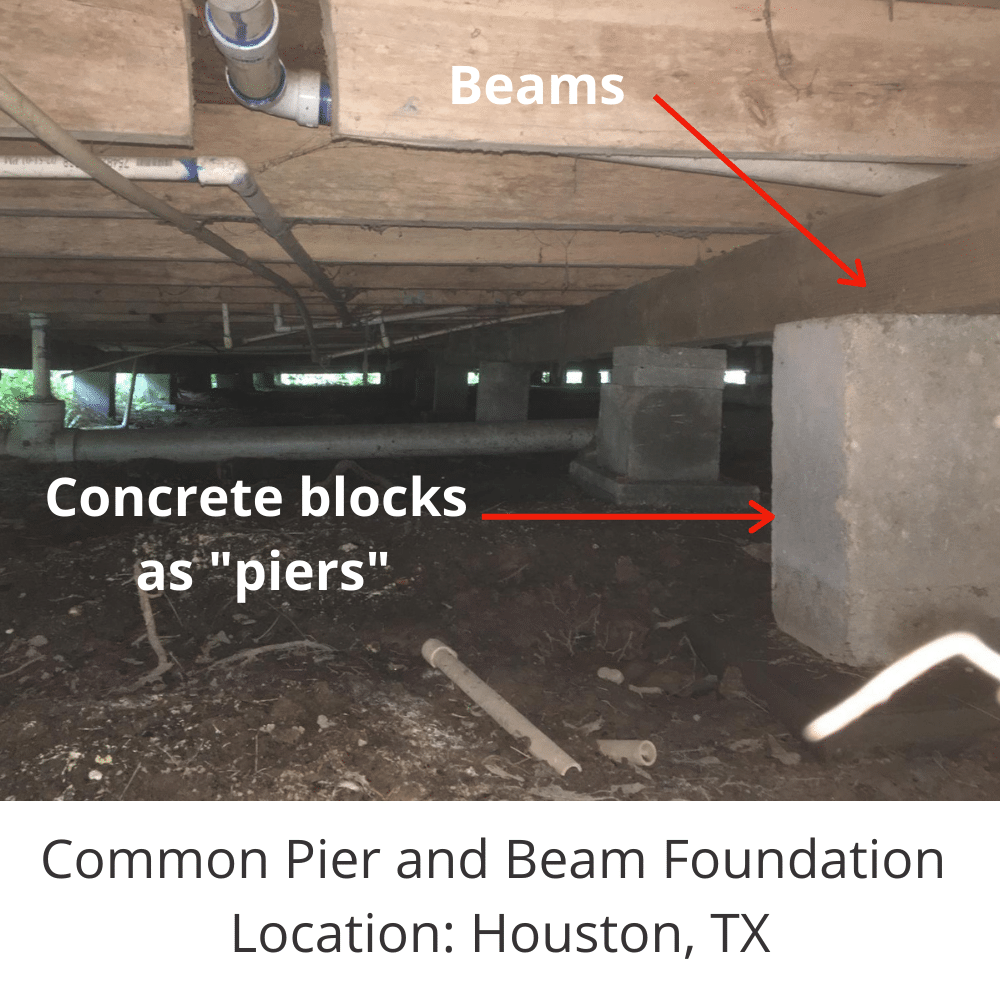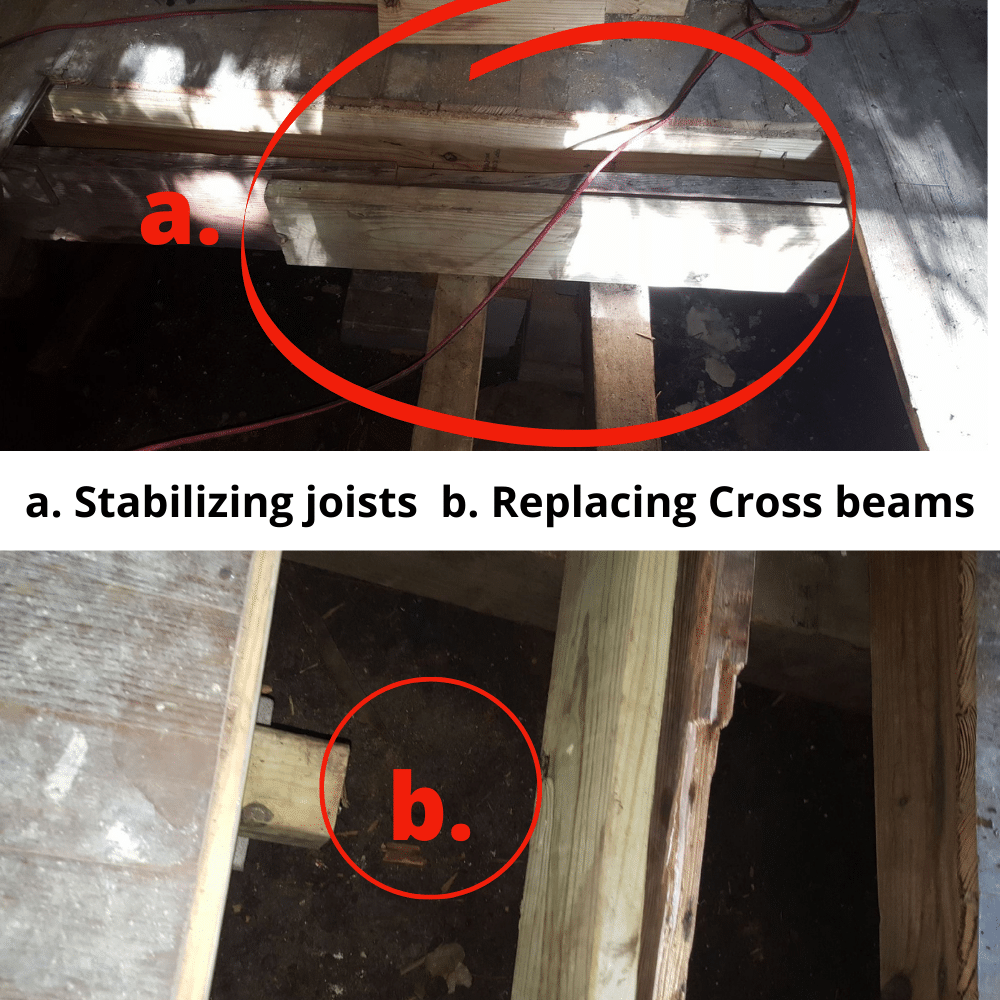Today most homes are built on a concrete slab and don’t utilize a pier and beam foundation design. However, homeowners might encounter this older foundation type when purchasing an existing home built during the era when crawl spaces were more common. Let’s discuss the pier foundation, and pier construction in general, so you can better evaluate the pros and cons.
What is a Pier and Beam Foundation?
Pier construction was very common in homes prior to the expansion boom of home ownership in the post war 1960’s. This was especially true in the South. At this time, the floating slab began to take over wooden beams as a preferred method in the construction process. Up North, concrete block wall or deep foundation setups, like basements, became more common.
Pier and beam design or a “raised foundation” is constructed using a concrete pier as a solid base for the wooden beams that hold up the floor of the home. Using a concrete pier ensures stability. Similarly, in modern construction, the strength and resilience of concrete are leveraged in various ways, such as in the form of concrete sleepers for retaining walls where sloping is in play.
This is a much different approach than poured concrete, because a raised home does not sit directly on the ground. Instead, this creates what is known as a crawlspace foundation where space exists between the ground and the actual floor of the home. This foundation type results in some pro’s and con’s that we can now explore. See below, as many older homes utilize concrete block in place of actual piers.
What are the Pros and Cons of Pier and Beam Foundation?
Every building method carries upsides and downsides, and this foundation type is no different. It should be noted that geography plays a role in the benefits of having a crawl space foundation. If you live in an area of the country that is prone to flooding, such as parts of Houston, TX, the benefit of a raised house foundation can be the main factor you consider. Here are some additional benefits as well.
Benefits or Pros of a Pier and Beam Foundation
- Protection from rising flood waters reaching your living space
- Avoidance of foundation damage due to cracks in concrete slab from clay soil changes
- Better access to plumbing pipes, HVAC ducts, and electrical wiring from crawlspace
- Easier and cheaper repairs (due to specific access to problem) from crawl space
Cons of a Pier and Beam Foundation Type
- Increased access by pests (animals, but also bugs including termites) via the crawl space
- More dampness and cold air affecting home temperature during winter
- Additional “give” in floors due to less support of slab foundation, creating squeaks or noise
- Foundation repair required of old footing or rotting wooden beams
- Expensive in new construction, particularly when a helical pier, steel beam or caisson is used in pier construction
Should you Buy a Home with a Pier and Beam Foundation?
You should consider the pros and cons of a pier and beam foundation mentioned above when deciding this foundation type over a concrete slab or even basement construction. If you’re looking at an older home, it will be important to have an inspection done by an experienced foundation repair contractor.
They will give special attention to the condition of each concrete pier, the soil condition of the ground or clay soil beneath, and of course if any foundation issues exist. You can also look to a structural engineer for a more precise evaluation of the raised foundation. They can measure the height of the piers and note any inconsistencies due to soil conditions, and if leveling should be considered.
Location Specific Considerations: Flooding
Flood protection from a raised foundation can be the best insurance available in areas known to rising water. This reason alone is why many people in the Houston area actually seek out a pier and beam foundation type. You can often access historical water levels from previous floods in the area, and by this measure the height of your new potential home relative to potential damage. (This is true for Houston data.)
Soil Type and Conditions: Less Costly Repairs
Some homes are built in areas where very expansive soil conditions exist. These can lead to costly foundation repairs as the clay soil expands and contracts over time. A Pier foundation is often less costly to repair than concrete or a basement foundation is due to logistics and labor costs.
The issues can be isolated to specific, and often very accessible areas in the crawlspace. This often makes it more cost effective than slab foundation repair. Of course, there are always exceptions. Each home should be evaluated based upon its own specific condition.
Pier and Beam Foundation Repair
If you need a company to address foundation repair problems, it will most likely involve fixing or replacing an individual concrete pier or multiple piers under the crawl space. A solid concrete footing is necessary for the beams to adequately support the home.
If the foundation problem is a result of rotten wooden beams, it is recommended these be replaced as soon as possible to avoid future damage to your home. We offer pier and beam foundation repair in Houston, and will provide you with a detailed report and estimate on what you can expect.
The Drilled Pier: Better than Standard Concrete Footings?
The drilled pier has grown in popularity in recent years with the advancement of technology. This scores another point on the pro’s of pier and beam design, but these are also used in slab foundation repair. A drilled pier doesn’t just sit on the ground, but is driven into the ground and into bedrock. This provides the most stable base and can help you avoid future foundation issues.
If you are in an older home, utilizing a drilled pier will be a more expensive upgrade for your repair but will provide longevity in fixing your issues. In most new construction settings, a drilled pier, also referred to as a helical pier, are commonly used from the beginning. This is one reason why upfront costs are more expensive than a poured concrete foundation.
Is a Pier and Beam Foundation Right For You? Weigh the Pro’s and Con’s
Hopefully this short article was helpful in you determining which foundation type meets your objectives. The biggest consideration on new construction is the cost per square foot. Existing homes that are situated in a place where a standard concrete slab foundation might pose increased risk due to flooding is a big consideration.
While a concrete floor or monolithic slab are the most common approaches to home construction today in the South where clay soil is present, you will still find newer raised homes, and this is still a viable method.
This shouldn’t deter you just because it’s not as common. The best policy is to have the individual pier and beam foundation evaluated by a trusted expert or structural engineer prior to purchase, and make your decision based upon your report.
If you are in an existing home and trying to learn more about your pier and beam foundation, we welcome you to reach out. Talk to one of our experts in more detail about the pros and cons of pier and beam foundation as it relates to your house situation, how you can properly maintain it, and when to consider repairs. Please get in touch, as we are here to help.





